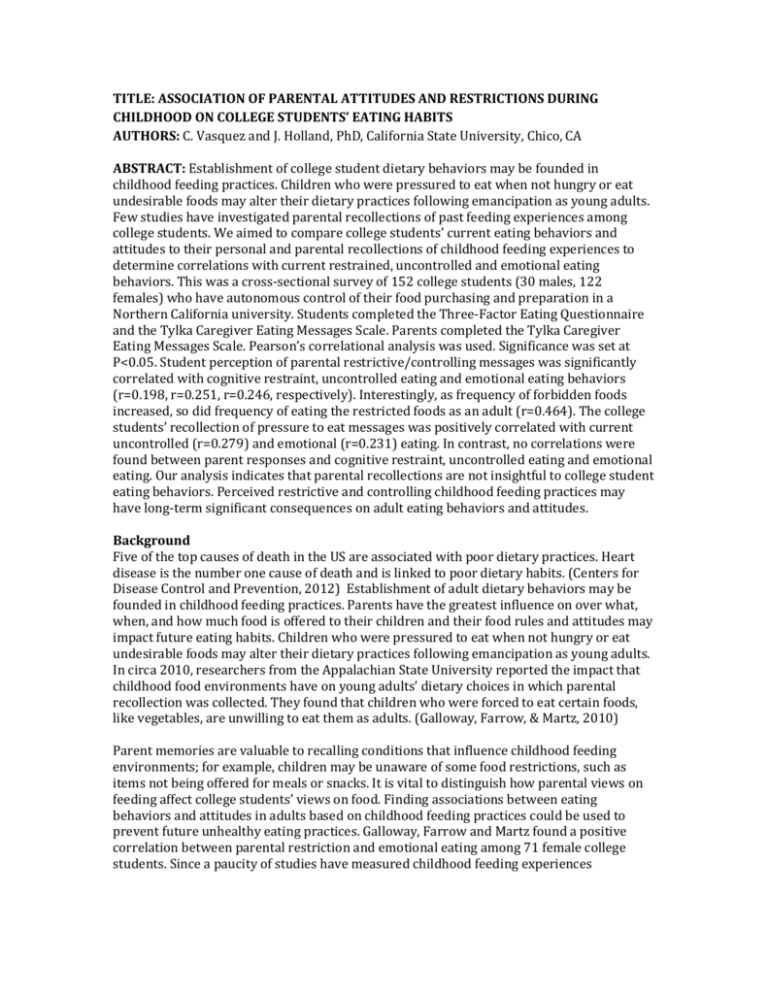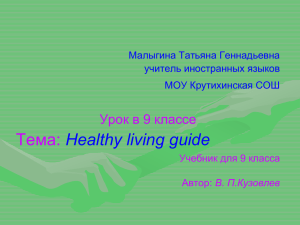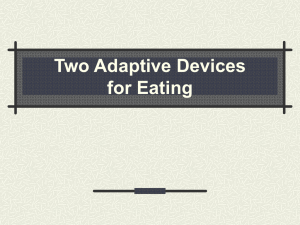File
advertisement

TITLE: ASSOCIATION OF PARENTAL ATTITUDES AND RESTRICTIONS DURING CHILDHOOD ON COLLEGE STUDENTS’ EATING HABITS AUTHORS: C. Vasquez and J. Holland, PhD, California State University, Chico, CA ABSTRACT: Establishment of college student dietary behaviors may be founded in childhood feeding practices. Children who were pressured to eat when not hungry or eat undesirable foods may alter their dietary practices following emancipation as young adults. Few studies have investigated parental recollections of past feeding experiences among college students. We aimed to compare college students’ current eating behaviors and attitudes to their personal and parental recollections of childhood feeding experiences to determine correlations with current restrained, uncontrolled and emotional eating behaviors. This was a cross-sectional survey of 152 college students (30 males, 122 females) who have autonomous control of their food purchasing and preparation in a Northern California university. Students completed the Three-Factor Eating Questionnaire and the Tylka Caregiver Eating Messages Scale. Parents completed the Tylka Caregiver Eating Messages Scale. Pearson’s correlational analysis was used. Significance was set at P<0.05. Student perception of parental restrictive/controlling messages was significantly correlated with cognitive restraint, uncontrolled eating and emotional eating behaviors (r=0.198, r=0.251, r=0.246, respectively). Interestingly, as frequency of forbidden foods increased, so did frequency of eating the restricted foods as an adult (r=0.464). The college students’ recollection of pressure to eat messages was positively correlated with current uncontrolled (r=0.279) and emotional (r=0.231) eating. In contrast, no correlations were found between parent responses and cognitive restraint, uncontrolled eating and emotional eating. Our analysis indicates that parental recollections are not insightful to college student eating behaviors. Perceived restrictive and controlling childhood feeding practices may have long-term significant consequences on adult eating behaviors and attitudes. Background Five of the top causes of death in the US are associated with poor dietary practices. Heart disease is the number one cause of death and is linked to poor dietary habits. (Centers for Disease Control and Prevention, 2012) Establishment of adult dietary behaviors may be founded in childhood feeding practices. Parents have the greatest influence on over what, when, and how much food is offered to their children and their food rules and attitudes may impact future eating habits. Children who were pressured to eat when not hungry or eat undesirable foods may alter their dietary practices following emancipation as young adults. In circa 2010, researchers from the Appalachian State University reported the impact that childhood food environments have on young adults’ dietary choices in which parental recollection was collected. They found that children who were forced to eat certain foods, like vegetables, are unwilling to eat them as adults. (Galloway, Farrow, & Martz, 2010) Parent memories are valuable to recalling conditions that influence childhood feeding environments; for example, children may be unaware of some food restrictions, such as items not being offered for meals or snacks. It is vital to distinguish how parental views on feeding affect college students’ views on food. Finding associations between eating behaviors and attitudes in adults based on childhood feeding practices could be used to prevent future unhealthy eating practices. Galloway, Farrow and Martz found a positive correlation between parental restriction and emotional eating among 71 female college students. Since a paucity of studies have measured childhood feeding experiences correlation with adult eating behaviors and attitudes, it is critical to survey both parents and students. Finding associations between eating behaviors and attitudes in adults based on childhood feeding practices could be used to prevent future unhealthy eating practices. Galloway, Farrow and Martz, found a positive correlation between parental restriction and emotional eating among 71 female college students. However, the mean age of the Appalachian State University participants was 18.5 ± 0.95 years. Their campus requires freshmen to live in the dorms. These students did not have complete autonomous control over their food choices. (Galloway, Farrow, & Martz, 2010) The purpose of this study was to further investigate the relationships between recollections of childhood feeding practices and college students’ current eating behaviors, attitudes and behaviors amongst students who have autonomous control over their food choices. Methods Data Collection Convenient sampling of students was done through student email announcements, social media and class announcements. Students from California State University, Chico (CSUC) who have autonomous control of their food purchasing and preparation participated in this cross-sectional survey either online (using SurveyMonkey) or completed a paper survey in class. Participation was voluntary and written consent was obtained from all participants. Compensation for students was the opportunity to win a $50 gift certificate to Amazon. Students were asked to provide their parent or caregiver’s mailing address and surveys were mailed with self-addressed stamped return envelopes to caregivers. Caregiver surveys were mailed along with a self-addressed stamped envelope. Compensation for caregivers was the opportunity to win a $50 gift certificate to Amazon. Student and caregiver surveys were matched via a unique identification number given to each survey. Data Obtained Students provided demographic information, including: sex, age, class standing, how long it has been since they moved out of their parents’ home, and current living situation. Using validated questionnaires, a retrospective study was conducted to surveying students regarding childhood eating behaviors and restrictions and compare current eating behaviors and attitudes regarding food. To measure students’ current eating behaviors, the Three-Factor Eating Questionnaire—Revised 18-Item (TFEQ-R18) was used; this survey measures eating behaviors by examining levels of restrained eating, external eating (eating for reasons other than hunger), and emotional eating. (de Lauzon et al., 2004) TFEQ-R18 survey was used with permission. To measure student perceptions of parental food restrictions and pressure to eat messages, the Tylka Caregiver Eating Messages Scale was used. The Tylka Caregiver Eating Messages Scale was used with permission. Students were asked to rate themselves on a Likert scale from 1 to 8 on how restrained they are in their current eating patterns where “1” means no restraint in eating (eating whatever you want, whenever you want it) and “8” means total restraint (constantly limiting food intake and never “giving in”). Restraining eating is defined as: an anxious state where you never let yourself eat what you want or you're always watching what you eat. Restrained eating can be an indicator of disordered eating behaviors. Students compared their dietary restrictions as children to their current eating behaviors in question number 25 of the student survey. Students were asked if their caregiver would not allow them to eat certain foods and if they now eat these previously restricted foods. This was rated on a semantic differential scale from “never” to “always”. To measure caregiver’s perceptions of restrictions and pressure to eat messages that were placed on their children, caregiver survey was adapted from the Tylka Caregiver Eating Messages Scale. (Kroon Van Diest & Tylka, 2010) Scoring of surveys The Three-Factor Eating Questionarrie-R18 Students’ current eating behaviors were evaluated as follows: “Cognitive Restraint Scale” was calculated by averaging items 8, 17, 18, 21, 22, and 24. “Uncontrolled Eating Scale” was calculated by averaging items 7, 10, 13, 14, 15, 19, 20, and 23. “Emotional Eating Scale” was calculated by averaging items 9, 12, and 16. Students’ perceptions of childhood eating behaviors were evaluated as follows: “Pressure to Eat Messages” (PEM) was calculated by averaging items 26, 27, 28, 29, 34, and 39. “Restrictive and Critical Messages” (RCM) was calculated by averaging items 30, 31, 32, 33, 35, 36, 37, 38, 40 and 41. Tylka Caregiver Eating Messages Scale To evaluate caregiver’s perceptions of how their children ate when they were children and messages that were given to them were evaluated using the “Parent Survey.” “Pressure to Eat Messages” (PEM) was calculated by averaging items 1, 2, 3, 4, 9, 16, and 17. “Restrictive and Critical Messages” (RCM) was calculated by averaging items 5, 6, 7, 8, 10, 11, 12, 13, 14, 15, and 18. Statistical Analyses Descriptive and Pearson’s correlational analyses were performed using IBM SPSS Statistics software. The University Institutional Review Board approved this study. Results Subject demographics 287 students responded to the survey, however if both student and caregiver surveys were not completed, student responses were excluded. A total of 152 college students (30 males and 122 females) and one of their primary caregivers responded to the survey. Subjects were between the ages of 18 and 28. 17.8% were freshman, 13.2% were sophomores, 27.0% were juniors, 37.5 were seniors and 4.6% did not report their class level. All students reported autonomous control over their food choices, 13.8% lived in the dormitories, 57.9% lived with roommates, 13.8% lived with their spouse, and 7.2% lived alone. 7.3% did not report their living situation. Recollections of childhood feeding practices Relationship between students’ and caregivers’ recollection of childhood feeding practices are shown in Table 1. Student and caregiver reports of “pressure to eat” messages do not correlate, however memories of “restrictive and controlling message” are correlated. (p < .000). Our analysis indicates that parental recollections are not insightful to college student eating behaviors. Childhood memories of “pressure to eat” messages and memories of “restrictive and controlling” messages received are greater correlated to current eating patterns verse actual caregiver messages. Perceived restrictive and controlling childhood feeding practices may have long-term significant consequences on adult eating behaviors and attitudes. Relationship between childhood memories and current eating behaviors Student perception of parental restrictive/controlling messages was significantly correlated with cognitive restraint, uncontrolled eating and emotional eating behaviors (r=0.198, r=0.251, r=0.246, respectively). Interestingly, as frequency of forbidden foods increased, so did frequency of eating the restricted foods as an adult (r=0.464). The college students’ recollection of pressure to eat messages was positively correlated with current uncontrolled (r=0.279) and emotional (r=0.231) eating. In contrast, no correlations were found between parent responses and cognitive restraint, uncontrolled eating and emotional eating. Cognitive Restraint Cognitive Restraint - Uncontrolled Eating Emotional Eating .130 .110 .239** .003 .405** .000 .130 .110 .239** .405** Emotional Eating .003 .000 Pressure to Eat -.132 .017 Messages Given .106 .840 Pressure to Eat .075 .279** Messages Received .358 .001 Restrictive/Controlling -.054 .130 Messages Given .505 .111 Restrictive/Controlling .198* .251** Messages Received .014 .002 ** Correlation is significant at the 0.01 level (2-tailed). * Correlation is significant at the 0.05 level (2-tailed). Significant P < 0.001 Uncontrolled Eating -.038 .640 .231** .001 .000 1.000 .246** .002 Pressure to Eat Messages Given .132 .106 .017 .840 -.038 .640 .118 .149 .353** .000 .101 .216 Pressure to Eat Messages Received .075 .358 .279** .001 .231** .004 .118 .149 Restrictive/Controlling Messages Given Restrictive/Controlling Messages Received -.054 .505 .130 .111 .000 1.000 .353** .000 .036 .659 .198* .014 .251** .002 .246** .002 .101 .216 .154 .059 .346** .000 .036 .659 .154 .059 .346** .000 - Table 1. Pearson’s two-tailed correlation for parent-reported and student-reported childhood and current feeding practices Student currently consumes this previously restricted food Parent would not allow child to eat certain foods .464** .000 ** Correlation is significant at the 0.01 level (2-tailed). Significant P < 0.001 Table 2. Pearson’s two-tailed correlation for studentreported consumption of previously restricted foods Discussion This study compared past eating experiences with current eating behaviors. Results indicate a correlation between past restrictions and control and pressure to eat to uncontrolled eating and emotional eating. By pressuring to children to alter their natural hunger and fullness cues they are likely to have disordered eating patterns as adults. Previous research by Dr. Janet Polivy and Dr. Peter Herman also indicates that restrained eating is linked to cycles of restrained eating and uncontrolled and emotional eating. (Polivy, 1996) When dietary restraint includes denying physiology there are emotional consequences which make it increasingly difficult to maintain that restraint. (Herman & Polivy, 1980) Results of this study suggest that by not pressuring children to eat or to restrict may lead to greater eating competence as adults. This research supports Ellyn Satter’s eating competence model and the division of responsibility. The Satter Eating Competence Model is based on internal cues of hunger and satiety. If these cues are appropriately attended to as children, adults will have a positive attitude regarding eating and be able to enjoy a variety of foods. (Satter, 2007) Our study was limited by its cross-sectional design (and thus inability to determine causal relationships), its convenience sample, and its use of self-reported measures of childhood memories, and dietary restraint and disinhibition. Additionally, we did not have an equal number of males and females respond to our survey, so these results may not be accurate for men and women. The CSUC Research and Creativity Grant provided funding for this study. Restrictive/Controlling Messages Received Cognitive Restraint Uncontrolled Eating Emotional Eating Figure 1. Significant correlation between restrictive and controlling message received by children and eating behaviors as young adults. Pressure to Eat Messages Received Uncontrolled Eating Emotional Eating Figure 2. Significant correlation between pressure to eat message received by children and eating behaviors as young adults. Parent restriction of "forbidden" food items Consumption of "forbidden" food as an adult Figure 3. Significant correlation between restriction of food items by parents on children and young adult current eating behaviors. Works Cited Centers for Disease Control and Prevention. (2012, 10 19). Leading Causes of Death. Retrieved 10 30, 2012, from Centers for Disease Control and Prevention: http://www.cdc.gov/nchs/fastats/lcod.htm de Lauzon et al. (2004, May 29). The Three-Factor Eating Questuinnaire-R18 Is Able to Distinguish among Different Eating Patterns in a General Population. Nutritional Epidemiology , 2372-2380. Galloway, A. T., Farrow, C. V., & Martz, D. M. (2010). Retrospective Reports of Child Feeding Practices, Current Eating Behaviors, and BMI in College Students . Obesity Journal , 18 (7), 1330-1335. Herman, C. P., & Polivy, J. (1980). Restrained Eating. Obesity , 208-225. Kroon Van Diest, A. M., & Tylka, T. L. (2010, June 11). The Caregiver Eating Messages Scale: DEvelopment and psychometric investigation. Body Image . Polivy, J. (1996). Psychological consequences of food restriction. J Am Diet Assoc , 96 (6), 589-592. Satter, E. (2007). Definition and evidence for the Satter Eating Competence Model. Journal Of Nutrition Education and Behavior , 39 (5), S142-S153.







